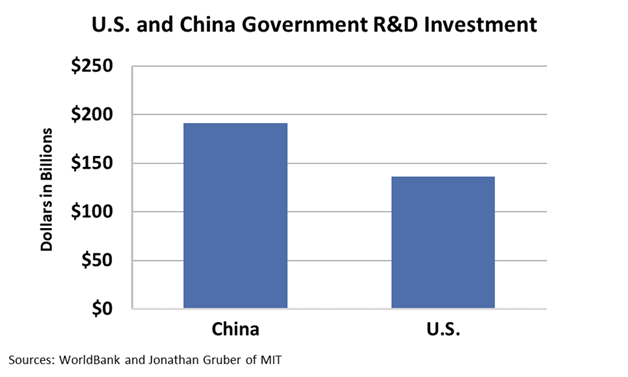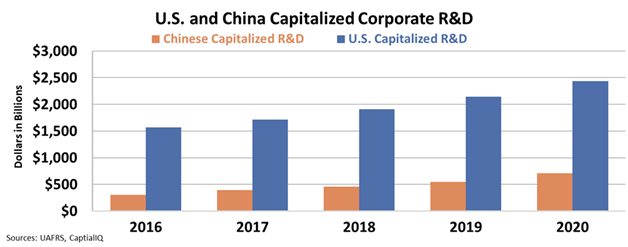In the race to hyperpower status between China and the US, here is what the media misses

Some media pundits think the U.S. is falling behind China in innovation and suggest that China is blowing past the U.S. in artificial intelligence (“AI”), clean energy, and biotechnology.
Recently, a New York Times article highlighted the usual thesis that thanks to this investment, China is threatening to take over hyperpower status from the U.S. in the near future.
Today, we are going to dive into the real accounting numbers to understand if this is a real risk, or just blown smoke.
Investor Essentials Daily:
The Monday Macro Report
Powered by Valens Research
China directs 1.3% of gross domestic product (“GDP”) every year on research and development (“R&D”). Once the beacon of innovation, U.S. government-sponsored R&D spending has dropped from a peak of 1.8% of GDP in the mid-1960s to a measly 0.65% today.
That pure R&D budget helped create the now ubiquitous semiconductor, led to the invention of the Internet, and even led to the creation of the technology used for the COVID-19 vaccines.
Some experts say pure early-stage R&D needs to be funded by the government. Companies simply won’t take it on for several reasons:
- It takes too long for this type of R&D to pay off.
- The possibility of it failing is too high.
- The probability that the innovation will not be relevant for the industry you originally planned for is too high.
The narrative glosses over many key details as they were getting in the way of the story. I’ve been called by the Pentagon, the U.S. Marine Corps, and the FBI to present our insights on the U.S. competition with China because our data breaks through the noise.
First, let’s jump into that 1.3% of GDP versus 0.65% of GDP figure. Yes, it sounds terrifying. On the surface, it appears like the Chinese government is investing 2 times what the U.S. is investing in R&D.
But context is a powerful tool, and we need to step back to see the full picture.
As of 2020, China’s GDP is still only 70% of the U.S., so the U.S. government is spending a lot more than half as much on pure R&D.
The federal government spends about $135 billion on R&D, versus China’s $190 billion. It’s still a $55 billion gap, but it’s not as dire as the news headlines may suggest.

While the U.S. government is underinvesting in R&D relative to China, it’s not nearly as much as most headlines imply.
Furthermore, pure R&D is not only a job for governments anymore.
While many examples point to how so much of our pure R&D has come from government funding historically, private financing is a lot more important to investing in innovation now than it was back in the 1960s.
For instance, Alphabet (GOOGL) spent $30 billion on R&D in the last 12 months, and that alone makes up more than half of the gap between the U.S. and Chinese government-funded R&D.
Alphabet isn’t spending $30 billion on optimizing Google Search, YouTube’s “next video” feature, or figuring out how to finally make lookup work in Google Sheets. It is spending it on home run ideas. There’s a reason it used to have a group called moonshots, now called X Development.
Alphabet has invested and continues to invest in pure R&D ideas, like Waymo for autonomous vehicles, Dandelion in geothermal energy, Malta in salt-based energy storage solutions, Taara and Loon in ubiquitous networking access, and DeepMind in complex AI innovation, just to name a few areas it has and is investing.
Some of that is funded by the government. Waymo competed for Defense Advanced Research Projects Agency (“DARPA”) funding to help fund the R&D. But far more of that funding comes from Alphabet’s legacy businesses than from DARPA.
Alphabet isn’t the only public company investing in moonshots that used to only come from government funding.
Intel (INTC) is regularly seeding future innovation. Boeing (BA) and Airbus (AIR.PA) invest billions of their own money in creating technology for planes that might not fly for a decade or more.
Last year, public Chinese companies spent $190 billion in total R&D. They effectively doubled the government’s R&D spending.
U.S corporations spent $540 billion in total R&D. That doesn’t just make up for government funding differences. That investment alone blows by the Chinese government and corporate spending combined.
And the important thing about R&D is it is a long-term investment. A one-year snapshot doesn’t do justice for understanding how R&D can fuel innovation.
That’s why under Uniform Accounting, we capitalized R&D and looked at the total investment corporations are making over time. That is a far better indicator of future innovation and revenues. And it paints an even more powerful picture.

U.S. corporate R&D investment dwarfs Chinese corporate R&D. As of last year. There was $2.4 trillion in useful R&D innovation as an asset sitting on U.S. balance sheets and only $700 billion on Chinese balance sheets.
That is a $1.7 trillion gap. And Chinese companies aren’t catching up, they’re falling behind more, year after year. In 2019, they were only $1.6 trillion behind. In 2011, they were only $1 trillion behind.
Even that doesn’t paint how far behind China’s curve relative to the U.S. on the innovation that will fuel the next 10 and 30 years of economic growth.
Some of the most important innovations are happening in the world of venture capital (“VC”), where China badly lags the U.S. While our analysis generally focuses on public companies, we pay close attention to the pipeline of innovation heading towards the public market.
Approximately 57% of the current U.S. corporate market capitalization comes from companies founded in 1979 and backed by VC companies.
When you look at the largest companies in the world, five of the top six and six of the top 10 are U.S. listed companies that were VC funded, and only two are Chinese companies.
Venture capitalists help fund and seed the next big ideas, which will be some of the biggest companies decades from now. It’s not just current innovation that the U.S. leads on, and it dominates here too.
In the first quarter of 2021, there were $62.1 billion in U.S. venture investment deals. That was a new record, and it was more than double the highest levels pre-pandemic. From the beginning of the pandemic until the end of the first quarter, $167 billion was invested.
In 2020, Chinese startup investment was roughly $125 billion in today’s dollars. That looks like they’re closer in this field, but it hides an important point.
While U.S. venture funding continues to grow, the number of Chinese VC deals has been dropping every year for five years running. Total deal volume in 2020 was less than half the deal volume in 2015 and 2016. Chinese innovation is going the wrong way.
So rest assured, contrary to what some members of the media may want you to believe to sell emotions instead of facts, U.S. innovation is alive and well.
Best regards,
Joel Litman
Chief Investment Strategist
at Valens Research




